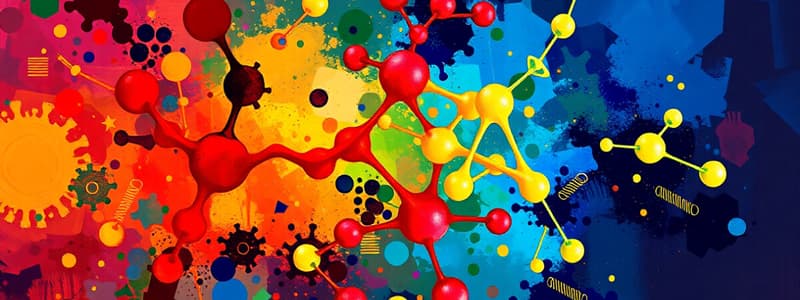Podcast
Questions and Answers
What are the building blocks of proteins?
What are the building blocks of proteins?
Amino acids
Zwitterions are molecules that are overall neutral and have a distinct positive ion on one end and a distinct negative ion on the other end.
Zwitterions are molecules that are overall neutral and have a distinct positive ion on one end and a distinct negative ion on the other end.
True (A)
What is the difference between nonpolar and polar amino acids?
What is the difference between nonpolar and polar amino acids?
- Nonpolar amino acids contain alcohols, thiols, and amides. Polar amino acids contain hydrogen and carbon chains in their R group.
- Nonpolar amino acids contain hydrogen and carbon chains in their R group. Polar amino acids contain hydrogen, oxygen, and nitrogen.
- Nonpolar amino acids contain hydrogen and carbon chains in their R group. Polar amino acids contain alcohols, thiols, and amides. (correct)
- Nonpolar amino acids contain an amine in their R group. Polar amino acids contain a carboxylic acid in their R group.
The ______ is formed from the combining of two amino acids.
The ______ is formed from the combining of two amino acids.
What is the N terminus of a protein?
What is the N terminus of a protein?
List the four levels of protein structre.
List the four levels of protein structre.
Which of these is NOT a secondary structure of proteins?
Which of these is NOT a secondary structure of proteins?
Tertiary structure interactions can happen between amino acids far apart in the primary sequence.
Tertiary structure interactions can happen between amino acids far apart in the primary sequence.
What type of interaction is a salt bridge?
What type of interaction is a salt bridge?
Quaternary structure is formed when two or more tertiary structures interact.
Quaternary structure is formed when two or more tertiary structures interact.
What is the function of an enzyme?
What is the function of an enzyme?
Enzymes are highly specific to the reactions they catalyze.
Enzymes are highly specific to the reactions they catalyze.
Describe the 'lock and key' model of enzyme function.
Describe the 'lock and key' model of enzyme function.
Flashcards
Amino acids
Amino acids
Building blocks of proteins
Zwitterions
Zwitterions
Amino acid molecules with both positive and negative charges.
Nonpolar amino acids
Nonpolar amino acids
Amino acids with hydrophobic R groups, often with hydrogen or carbon chains.
Polar amino acids
Polar amino acids
Signup and view all the flashcards
Acidic amino acids
Acidic amino acids
Signup and view all the flashcards
Basic amino acids
Basic amino acids
Signup and view all the flashcards
Peptide
Peptide
Signup and view all the flashcards
Dipeptide
Dipeptide
Signup and view all the flashcards
Tripeptide
Tripeptide
Signup and view all the flashcards
Protein
Protein
Signup and view all the flashcards
Primary structure
Primary structure
Signup and view all the flashcards
Secondary structure
Secondary structure
Signup and view all the flashcards
Tertiary structure
Tertiary structure
Signup and view all the flashcards
Quaternary structure
Quaternary structure
Signup and view all the flashcards
Enzyme
Enzyme
Signup and view all the flashcards
Hydrophobic interactions
Hydrophobic interactions
Signup and view all the flashcards
Hydrophilic interactions
Hydrophilic interactions
Signup and view all the flashcards
N-terminus
N-terminus
Signup and view all the flashcards
C-terminus
C-terminus
Signup and view all the flashcards
Study Notes
Proteins
- Proteins are complex molecules composed of amino acids.
- Amino acids are the building blocks of proteins.
- They each have an amino group, a carboxyl group, and a side chain (R group).
- The R group distinguishes different amino acids.
Amino Acids
- Amino acids are the fundamental units of proteins.
- They have a central carbon atom bonded to an amino group, a carboxyl group, a hydrogen atom, and an R group.
- The R group varies among amino acids, giving them different properties.
Amino Acids as Zwitterions
- Zwitterions are molecules with both a positive and a negative charge.
- Amino acids exist as zwitterions at neutral pH.
- The amino group gains a positive charge, and the carboxyl group loses a proton, gaining a negative charge.
Classification of Amino Acids
- Amino acids are classified based on the properties of their R groups.
- Nonpolar amino acids contain mostly hydrocarbon chains in their R groups.
- Polar amino acids contain polar functional groups like alcohols, thiols, and amides in their R groups.
- Acidic amino acids have a carboxyl group in their R groups.
- Basic amino acids have an amine group in their R groups.
Classification Examples
- Specific examples of amino acid structures are shown with their respective functional group classifications.
Amino Acids Link Together to Form Peptides
- Amino acids link together via peptide bonds to form peptides (short chains) and proteins (long chains).
- A peptide bond forms between the carboxyl group of one amino acid and the amino group of another amino acid.
- Water is released in the process.
- A dipeptide is formed from two amino acids.
- A tripeptide is formed from three amino acids.
- N-terminus is the end of the amino acid chain with the free amino group.
- C-terminus is the end of the amino acid chain with a free carboxyl group.
Levels of Protein Structure
- Protein structure describes how amino acid sequences fold into complex three-dimensional shapes.
- Primary structure: The linear sequence of amino acids with a unique sequence. Differences in sequence lead to different 3-D structures.
- Secondary structure: Local folding of the polypeptide chain, often forming α-helices or β-sheets.
- Tertiary structure: Three-dimensional arrangement of the entire polypeptide chain through various interactions between R groups. Specific interactions include hydrogen bonds, hydrophobic interactions, salt bridges, and disulfide bonds.
- Quaternary structure: Structure formed from interactions between multiple polypeptide chains to form a functional protein complex
Enzymes
- Enzymes are biological catalysts that speed up biochemical reactions millions to billions of times faster.
- They do this without the need for extreme conditions like high temperatures or pressures.
- Enzymes are highly specific to a particular reaction.
- Each enzyme uniquely speeds up a specific reaction, and often use a "lock and key" mechanism (substrate binds to a specific region of the enzyme; the active site).
- Enzymes are essential for sustaining life.
How Enzymes Work
- Substrates bind to the active site of an enzyme.
- The enzyme's shape changes slightly to enhance substrate binding, and the enzyme/substrate complex is formed.
- The reaction occurs, and the enzyme transforms substrates into products.
- Products are released from the enzyme, and the enzyme returns to its original shape.
Studying That Suits You
Use AI to generate personalized quizzes and flashcards to suit your learning preferences.




